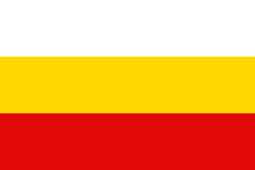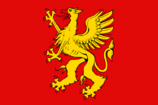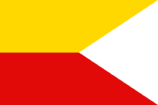Flag of Elstock: Difference between revisions
| (14 intermediate revisions by the same user not shown) | |||
| Line 1: | Line 1: | ||
{{Region icon Levilion}} | |||
{{Infobox flag | {{Infobox flag | ||
| Name = Elstock | | Name = Elstock | ||
| Line 28: | Line 29: | ||
| Design3 = A horizontal {{wp|bicolour}} of gold and red | | Design3 = A horizontal {{wp|bicolour}} of gold and red | ||
}} | }} | ||
The '''flag of Elstock''' ({{wp|Kashubian language|Elsian}}: ''fana Elstóku''; {{wp|German language|Tyrnican}}: ''Flagge Elstocks''), also referred to as the '''White-Gold-Red''' ({{wp|Kashubian language|Elsian}}: ''Biôłi-Złoto-Czerwòny''; {{wp|German language|Tyrnican}}: ''Weiß-Gold-Rot''), is the {{wp|Civil flag|civil}} and {{wp|state flag}} of the [[Elstock|Free City of Elstock]], consisting of a horizontal {{wp|Triband (flag)|triband}} made up of three equal bands of white, gold, and red. The flag is deliberately identical to the flag of the [[Elsians|Elsian]] ethnic group, who form a majority of Elstock's population, as well as nearly identical to the flag of the [[Senia|Senian]] region of [[Cernia]], differing in only hue | The '''flag of Elstock''' ({{wp|Kashubian language|Elsian}}: ''fana Elstóku''; {{wp|German language|Tyrnican}}: ''Flagge Elstocks''), also referred to as the '''White-Gold-Red''' ({{wp|Kashubian language|Elsian}}: ''Biôłi-Złoto-Czerwòny''; {{wp|German language|Tyrnican}}: ''Weiß-Gold-Rot''), is the {{wp|Civil flag|civil}} and {{wp|state flag}} of the [[Elstock|Free City of Elstock]], consisting of a horizontal {{wp|Triband (flag)|triband}} made up of three equal bands of white, gold, and red. The flag is deliberately identical to the flag of the [[Elsians|Elsian]] ethnic group, who form a majority of Elstock's population, as well as nearly identical to the flag of the [[Senia|Senian]] region of [[Cernia]], differing in only hue. | ||
The flag was first officially adopted by joint [[Tyrnica|Tyrnican]]-[[Pelemia|Pelemian]] authorities in 1919 alongside a {{wp|Swallowtail (flag)|swallowtail}} of gold and red as the city's {{wp|civil ensign| | The flag was first officially adopted by joint [[Tyrnica|Tyrnican]]-[[Pelemia|Pelemian]] authorities in 1919 alongside a {{wp|Swallowtail (flag)|swallowtail}} of gold and red as the city's {{wp|civil ensign|civil}} and {{wp|state ensign}}, as designated by an amendment to the 1915 ''Symbols of the Territory of Elstock Act''. In preparation for independence in 1999, a secondary state flag consisting of a red field charged with a gold griffin was made official through the constitution, which maintained the triband as the official flag of the city-state. | ||
==History== | ==History== | ||
The colours of the flag of Elstock originate from the city's coat of arms, which depict a gold griffin on a red field. The colours of gold (oftentimes also just referred to as yellow) and red later appeared on a bisected {{wp|Swallowtail (flag)|swallowtail}} in the 13th century, meant to mark ships under the employ of Elstocker merchants. This flag, alongside the city's {{wp|banner of arms}}, would become a symbol for the city throughout the early modern period, surviving the collapse of the [[ | The colours of the flag of Elstock originate from the city's coat of arms, which depict a gold griffin on a red field. The colours of gold (oftentimes also just referred to as yellow) and red later appeared on a bisected {{wp|Swallowtail (flag)|swallowtail}} in the 13th century, meant to mark ships under the employ of Elstocker merchants. This flag, alongside the city's {{wp|banner of arms}}, would become a symbol for the city throughout the early modern period, surviving the collapse of the [[Elstock#Decline and the early modern period|Elsian March]] and Pelemian control of Elstock. | ||
The first attested appearance of the modern triband was in 1867 during a rally protesting language restrictions in the town of Bãdzyń (now Bendzin, Pelemia). Popular folklore attributes the addition of a white stripe to the gold and red as a symbol of peace and aspiration for autonomy, and the flag quickly became popular within Elsian nationalist circles, who adopted the symbols of Elstock to represent the Elsian community at large. | The first attested appearance of the modern triband was in 1867 during a rally protesting language restrictions in the town of Bãdzyń (now Bendzin, Pelemia). Popular folklore attributes the addition of a white stripe to the gold and red as a symbol of peace and aspiration for autonomy, and the flag quickly became popular within Elsian nationalist circles, who adopted the symbols of Elstock to represent the Elsian community at large. | ||
| Line 45: | Line 46: | ||
</gallery> | </gallery> | ||
==Proportions and colours== | ==Design== | ||
===Construction=== | |||
[[File:Flag of Elstock (construction).png|thumb|500px|center|Construction sheet for the flag of Elstock]] | |||
===Proportions and colours=== | |||
The official proportions of the flag is 3:5, in accordance with the 1999 constitution. The flag's colours were also officially specified in 1999, and later amended in 2011 to address the use of the flag as an image on the Internet and social media. | The official proportions of the flag is 3:5, in accordance with the 1999 constitution. The flag's colours were also officially specified in 1999, and later amended in 2011 to address the use of the flag as an image on the Internet and social media. | ||
{| class="wikitable" width="600px" border="1" cellpadding="2" cellspacing="0" style="background: #f9f9f9; border: 1px solid #aaaaaa; border-collapse: collapse; white-space: nowrap; text-align: left" | {| class="wikitable" width="600px" border="1" cellpadding="2" cellspacing="0" style="background: #f9f9f9; border: 1px solid #aaaaaa; border-collapse: collapse; white-space: nowrap; text-align: left" | ||
| Line 73: | Line 78: | ||
|#E20909 | |#E20909 | ||
|} | |} | ||
==Controversy== | ==Controversy== | ||
[[File:CerniaFlag.png|thumb|upright=0.90|left|The flag of [[Cernia]], which uses the same colours and design, albeit in a darker hue]]The flag of Elstock is identical to the flag of the [[Elsians|Elsian]] ethnic group, who make up the majority of Elstock's population, and closely resembles the flag of the [[Senia|Senian]] region of [[Cernia]], differing only in hue. Elstock's use of the white-gold-red triband, as a deliberate use of the Elsian colours, has come with controversy in neighbouring countries. The flag, although not banned in [[Tyrnica]] and [[Pelemia]], are often dissuaded by local authorities, and in Pelemia, incidents have occurred over local police and governments removing the flag, even at private events. Despite this, the Elsian flag is visible at community events and organizations sponsored and supported by the Elsian minority in those countries, especially in private venues. | |||
The Elsian flag is not banned in Senia under the context of being the same design as the flag of Elstock, but has come under pressure as an ethnic symbol due to the belief that "the flag engenders separatism and acts of a terrorist nature" due to its association with the militant [[Elsian People's Army]] and the banned and marginalized [[Elsian People's Party]] within the country. Since 1915, the region of Cernia has used a similar flag of also white, gold, and red stripes, although the colours are more commonly used in a darker hue. Elsian activists in Senia and abroad have argued that Cernia's adoption of the flag is a form of appropriation and an attempt to equate the Elsian population of the region as ethically Senian or a sub-group of Senians. The Senian government has argued that the colours of the flag are based on the history of the region, and was created as a symbol to unify the four historical regions that make up the current administrative region of Cernia, with yellow, red and sometimes white have historically been associated with all four regions. Senia also argues that the Cernian flag predates the Elsian flag, as Cernia adopted the white-gold-red triband before Elstock's adoption of same design in 1919. The matter remains unresolved, and continues to sour Senian-Elstocker relations to the present day. | |||
{{Template:Elstock Topics}} | |||
[[Category:Culture of Elstock]] | |||
Latest revision as of 03:03, 23 May 2023
 | |
| Use | Civil and state flag |
|---|---|
| Proportion | 3:5 |
| Adopted | 10 August 1919 |
| Design | A horizontal triband of white, gold, and red |
 Variant flag of Elstock | |
| Use | State flag |
| Proportion | 3:5 |
| Adopted | 21 March 1999 |
| Design | A red field charged with a gold griffin rampant |
 Variant flag of Elstock | |
| Use | Civil and state ensign |
| Proportion | 3:5 |
| Adopted | 10 August 1919 |
| Design | A horizontal bicolour of gold and red |
The flag of Elstock (Elsian: fana Elstóku; Tyrnican: Flagge Elstocks), also referred to as the White-Gold-Red (Elsian: Biôłi-Złoto-Czerwòny; Tyrnican: Weiß-Gold-Rot), is the civil and state flag of the Free City of Elstock, consisting of a horizontal triband made up of three equal bands of white, gold, and red. The flag is deliberately identical to the flag of the Elsian ethnic group, who form a majority of Elstock's population, as well as nearly identical to the flag of the Senian region of Cernia, differing in only hue.
The flag was first officially adopted by joint Tyrnican-Pelemian authorities in 1919 alongside a swallowtail of gold and red as the city's civil and state ensign, as designated by an amendment to the 1915 Symbols of the Territory of Elstock Act. In preparation for independence in 1999, a secondary state flag consisting of a red field charged with a gold griffin was made official through the constitution, which maintained the triband as the official flag of the city-state.
History
The colours of the flag of Elstock originate from the city's coat of arms, which depict a gold griffin on a red field. The colours of gold (oftentimes also just referred to as yellow) and red later appeared on a bisected swallowtail in the 13th century, meant to mark ships under the employ of Elstocker merchants. This flag, alongside the city's banner of arms, would become a symbol for the city throughout the early modern period, surviving the collapse of the Elsian March and Pelemian control of Elstock.
The first attested appearance of the modern triband was in 1867 during a rally protesting language restrictions in the town of Bãdzyń (now Bendzin, Pelemia). Popular folklore attributes the addition of a white stripe to the gold and red as a symbol of peace and aspiration for autonomy, and the flag quickly became popular within Elsian nationalist circles, who adopted the symbols of Elstock to represent the Elsian community at large.
With the creation of Elstock as a condominium under joint rule by Tyrnica and Pelemia in 1914, attempts were made to create a flag for the territory that was deliberately separated from Elsian nationalism. The territory's first flag, adopted in 1915 and consisting of a green, white, and blue triband with the name of the city in Tyrnican, Elsian, and Dlin in the centre band, proved unpopular with both the public and authorities, and in 1916 the wording was removed and replaced by three gold stars. In 1919, after protests and riots continued against the flag, condominium authorities acquiesced and amended the Symbols of the Territory of Elstock Act to officially adopted the white-gold-red triband as the condominium's official flag. It has retained this position after independence in 2000.
Design
Construction
Proportions and colours
The official proportions of the flag is 3:5, in accordance with the 1999 constitution. The flag's colours were also officially specified in 1999, and later amended in 2011 to address the use of the flag as an image on the Internet and social media.
| Colours | White | Gold | Red |
|---|---|---|---|
| Pantone | Pure white | Medium Yellow C | 2347 C |
| CMYK | 0-0-0-0 | 0-15-100-0 | 0-96-96-11 |
| RGB | 255-255-255 | 255-216-0 | 226-9-9 |
| Hexadecimal | #FFFFFF | #FFD800 | #E20909 |
Controversy

The flag of Elstock is identical to the flag of the Elsian ethnic group, who make up the majority of Elstock's population, and closely resembles the flag of the Senian region of Cernia, differing only in hue. Elstock's use of the white-gold-red triband, as a deliberate use of the Elsian colours, has come with controversy in neighbouring countries. The flag, although not banned in Tyrnica and Pelemia, are often dissuaded by local authorities, and in Pelemia, incidents have occurred over local police and governments removing the flag, even at private events. Despite this, the Elsian flag is visible at community events and organizations sponsored and supported by the Elsian minority in those countries, especially in private venues.
The Elsian flag is not banned in Senia under the context of being the same design as the flag of Elstock, but has come under pressure as an ethnic symbol due to the belief that "the flag engenders separatism and acts of a terrorist nature" due to its association with the militant Elsian People's Army and the banned and marginalized Elsian People's Party within the country. Since 1915, the region of Cernia has used a similar flag of also white, gold, and red stripes, although the colours are more commonly used in a darker hue. Elsian activists in Senia and abroad have argued that Cernia's adoption of the flag is a form of appropriation and an attempt to equate the Elsian population of the region as ethically Senian or a sub-group of Senians. The Senian government has argued that the colours of the flag are based on the history of the region, and was created as a symbol to unify the four historical regions that make up the current administrative region of Cernia, with yellow, red and sometimes white have historically been associated with all four regions. Senia also argues that the Cernian flag predates the Elsian flag, as Cernia adopted the white-gold-red triband before Elstock's adoption of same design in 1919. The matter remains unresolved, and continues to sour Senian-Elstocker relations to the present day.





